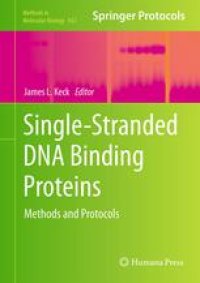
Ebook: Single-Stranded DNA Binding Proteins: Methods and Protocols
- Tags: Protein Science, Protein Structure
- Series: Methods in Molecular Biology 922
- Year: 2012
- Publisher: Humana Press
- Edition: 1
- Language: English
- pdf
The genomes of cellular organisms are organized as double-stranded DNA, a structure that must be unwound to provide DNA replication, recombination, and repair machinery access to genomic information. However, DNA unwinding comes with inherent risks to genome stability. To help mediate these risks, bacterial, archael, and eukaryotic cells have evolved protective ssDNA-binding proteins (SSBs) that bind ssDNA with high affinity and specificity. SSBs also aid genome metabolic processes through direct interactions with key proteins in genome maintenance enzymes. Single-Stranded DNA Binding Proteins: Methods and Protocols assembles methods developed for examining the fundamental properties of SSBs and for exploiting the biochemical functions of SSBs for their use as in vitro and in vivo reagents. Clearly and concisely organized, the volume opens with an introduction to the structures and functions of SSBs, followed protocols for studying SSB/DNA complexes, methods for studying SSB/heterologous protein complexes, protocols for interrogating post-translational modifications of SSBs, and concludes with uses of fluorescently-labeled SSBs for in vitro and in vivo studies of genome maintenance processes. Written in the successful Methods in Molecular Biology™ series format, chapters include introductions to their respective topics, lists of the necessary materials and reagents, step-by-step, readily reproducible protocols, and notes on troubleshooting and avoiding known pitfalls.
Authoritative and easily accessible, Single-Stranded DNA Binding Proteins: Methods and Protocols provides a rich introduction for investigators who are interested in this fascinating family of DNA-binding proteins.
The genomes of cellular organisms are organized as double-stranded DNA, a structure that must be unwound to provide DNA replication, recombination, and repair machinery access to genomic information. However, DNA unwinding comes with inherent risks to genome stability. To help mediate these risks, bacterial, archael, and eukaryotic cells have evolved protective ssDNA-binding proteins (SSBs) that bind ssDNA with high affinity and specificity. SSBs also aid genome metabolic processes through direct interactions with key proteins in genome maintenance enzymes. Single-Stranded DNA Binding Proteins: Methods and Protocols assembles methods developed for examining the fundamental properties of SSBs and for exploiting the biochemical functions of SSBs for their use as in vitro and in vivo reagents. Clearly and concisely organized, the volume opens with an introduction to the structures and functions of SSBs, followed protocols for studying SSB/DNA complexes, methods for studying SSB/heterologous protein complexes, protocols for interrogating post-translational modifications of SSBs, and concludes with uses of fluorescently-labeled SSBs for in vitro and in vivo studies of genome maintenance processes. Written in the successful Methods in Molecular Biology™ series format, chapters include introductions to their respective topics, lists of the necessary materials and reagents, step-by-step, readily reproducible protocols, and notes on troubleshooting and avoiding known pitfalls.
Authoritative and easily accessible, Single-Stranded DNA Binding Proteins: Methods and Protocols provides a rich introduction for investigators who are interested in this fascinating family of DNA-binding proteins.